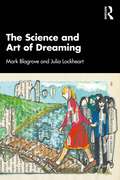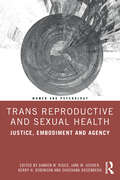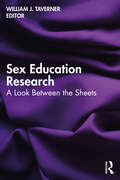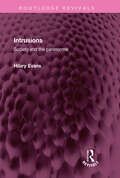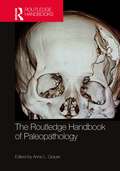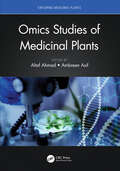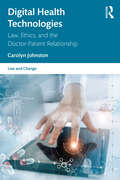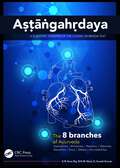- Table View
- List View
Co-Production in Mental Health: Implementing Policy into Practice
by Michael NortonThis book examines the recovery principle of co-production within mental health services, defining it as the creation of a space where all stakeholders – including service users, family members, carers and supporters – come together in a partnership to improve all aspects of mental health services. Exploring both the practicalities and complexities of co-production, the book provides detailed analyses of all aspects of the concept in relation to mental health and discusses the growing evidence-base for adopting co-production as a recovery approach within a mental health setting. The book’s chapters outline: the foundational principles in implementing the concept in services; the theories of co-production in and outside of mental health settings; how to translate theory into practice; and examples of implementation. The book also explores the sustainability of co-production and the tensions that are present between the idea of recovery and mental health policy. The volume represents an ideal introduction to the concept of co-production in mental health and will be valuable reading for those researching and working in the area of mental health services and recovery, including nurses, occupational therapists and social workers.
Deaf People and Society: Psychological, Sociological, and Educational Perspectives
by Irene W. Leigh Jean F. Andrews Cara A. Miller Ju-Lee A. WolseyDeaf People and Society is an authoritative text that emphasizes the complexities of being D/deaf, DeafBlind, Deaf-Disabled, or hard of hearing, drawing on perspectives from psychology, education, and sociology. This book also explores how the lives of these individuals are impacted by decisions made by professionals in clinics, schools, or other settings. This new edition offers insights on areas critical to Deaf Studies and Disability Studies, with particular emphasis on multiculturalism and multilingualism, as well as diversity, equity, and inclusion. Accessibly written, the chapters include objectives and suggested further reading that provides valuable leads and context. Additionally, these chapters have been thoroughly revised and incorporate a range of relevant topics including etiologies of deafness; cognition and communication; bilingual, bimodal, and monolingual approaches to language learning; childhood psychological issues; psychological and sociological viewpoints of deaf adults; the criminal justice system and deaf people; psychodynamics of interaction between deaf and hearing people; and future trends. The book also includes case studies covering hearing children of deaf adults, a young deaf adult with mental illness, and more.Written by a seasoned D/deaf/hard of hearing and hearing bilingual team, this unique text continues to be the go-to resource for students and future professionals interested in working with D/deaf, DeafBlind, and hard-of-hearing persons. Its contents will resonate with anyone interested in serving and enhancing their knowledge of their lived experiences of D/deaf, DeafBlind, Deaf-Disabled, and hard-of-hearing people and communities.
Deaf People and Society: Psychological, Sociological, and Educational Perspectives
by Irene W. Leigh Jean F. Andrews Cara A. Miller Ju-Lee A. WolseyDeaf People and Society is an authoritative text that emphasizes the complexities of being D/deaf, DeafBlind, Deaf-Disabled, or hard of hearing, drawing on perspectives from psychology, education, and sociology. This book also explores how the lives of these individuals are impacted by decisions made by professionals in clinics, schools, or other settings. This new edition offers insights on areas critical to Deaf Studies and Disability Studies, with particular emphasis on multiculturalism and multilingualism, as well as diversity, equity, and inclusion. Accessibly written, the chapters include objectives and suggested further reading that provides valuable leads and context. Additionally, these chapters have been thoroughly revised and incorporate a range of relevant topics including etiologies of deafness; cognition and communication; bilingual, bimodal, and monolingual approaches to language learning; childhood psychological issues; psychological and sociological viewpoints of deaf adults; the criminal justice system and deaf people; psychodynamics of interaction between deaf and hearing people; and future trends. The book also includes case studies covering hearing children of deaf adults, a young deaf adult with mental illness, and more.Written by a seasoned D/deaf/hard of hearing and hearing bilingual team, this unique text continues to be the go-to resource for students and future professionals interested in working with D/deaf, DeafBlind, and hard-of-hearing persons. Its contents will resonate with anyone interested in serving and enhancing their knowledge of their lived experiences of D/deaf, DeafBlind, Deaf-Disabled, and hard-of-hearing people and communities.
A Psychodynamic Approach to Female Domination in BDSM Relationships: Sexuality Between Pleasure and Work
by Nathalie LugandThis ground-breaking book explores contemporary forms of BDSM where women dominate in relationships and professions, opening new paths for psychological research in commercial and non-commercial BDSM. Based on a unique combination of qualitative investigation and academic research, it examines how BDSM has often crystalized conflicts in contemporary feminist debates, where sexually dominant women are pictured either as victims or as agents of resistance to the patriarchy. Nathalie Lugand argues that female domination in heterosexual BDSM is above all situated in a continuum structured by the values of care and by the circulation of money. Through a novel psychodynamic approach, Lugand demystifies BDSM relationships where women dominate, considering the impact of social relations of work in the construction of sexual identity and analyzing the difficulties that they cause in the erotic economy. The book affirms that to better understand the pleasure taken in female domination practices and the difficulties for women to impose themselves as dominatrixes, it is necessary to shift the focus away from transgressive aspects and look towards the workplace and the organisation of work in women's sexuality. Using field immersion to comprehensively investigate the blurred boundaries between life and work in the BDSM community, A Psychodynamic Approach to Female Domination in BDSM Relationships provides the opportunity for a new interpretation of sexuality, overturning the existing theoretical frameworks used in clinical psychology and psychoanalysis. This book is essential reading for researchers and academics in psychology, gender studies, political and social sciences, and human sexuality, as well as activists defending the human rights of sex workers around the world.
A Psychodynamic Approach to Female Domination in BDSM Relationships: Sexuality Between Pleasure and Work
by Nathalie LugandThis ground-breaking book explores contemporary forms of BDSM where women dominate in relationships and professions, opening new paths for psychological research in commercial and non-commercial BDSM. Based on a unique combination of qualitative investigation and academic research, it examines how BDSM has often crystalized conflicts in contemporary feminist debates, where sexually dominant women are pictured either as victims or as agents of resistance to the patriarchy. Nathalie Lugand argues that female domination in heterosexual BDSM is above all situated in a continuum structured by the values of care and by the circulation of money. Through a novel psychodynamic approach, Lugand demystifies BDSM relationships where women dominate, considering the impact of social relations of work in the construction of sexual identity and analyzing the difficulties that they cause in the erotic economy. The book affirms that to better understand the pleasure taken in female domination practices and the difficulties for women to impose themselves as dominatrixes, it is necessary to shift the focus away from transgressive aspects and look towards the workplace and the organisation of work in women's sexuality. Using field immersion to comprehensively investigate the blurred boundaries between life and work in the BDSM community, A Psychodynamic Approach to Female Domination in BDSM Relationships provides the opportunity for a new interpretation of sexuality, overturning the existing theoretical frameworks used in clinical psychology and psychoanalysis. This book is essential reading for researchers and academics in psychology, gender studies, political and social sciences, and human sexuality, as well as activists defending the human rights of sex workers around the world.
The Science and Art of Dreaming
by Mark Blagrove Julia LockheartThe Science and Art of Dreaming is an innovative text that reviews the neuroscience and psychology of how dreams are produced, how they are recalled and their relationship to waking life events and concerns of the dreamer. Featuring beautiful original artwork based on dream representations, the book delves deeply into what happens when we dream, the works of art we produce when asleep and the relevance of dreaming to science, art and film. The book examines the biological, psychological and social causes of dreaming, and includes recent advances in the study of nightmares and lucid dreaming. It shows how sleep can process memories and that dreams may reflect these processes, but also that dreams can elicit self-disclosure and empathy when they are shared after waking. The playfulness, originality and metaphorical content of dreams also link them to art, and especially to the cultural movement that has most valued dreams – Surrealism. The book details the history of scientific research into dreams, including a re-reading of the two dreams of Freud’s patient, the feminist hero Dora, and also the history of Surrealism and of films that draw on dreams and dream-like processes. Each chapter starts with a dream narrative and accompanying painting of the dream to highlight aspects of each of the chapter themes. This highly engaging book will be relevant to researchers, students and lecturers in the fields of psychology, neuroscience, psychoanalysis, consciousness and social evolution. It will also be of value within the study and practice of visual art, design and film, and will be of interest to the general reader and anyone who holds a personal interest in their own dreams.
The Science and Art of Dreaming
by Mark Blagrove Julia LockheartThe Science and Art of Dreaming is an innovative text that reviews the neuroscience and psychology of how dreams are produced, how they are recalled and their relationship to waking life events and concerns of the dreamer. Featuring beautiful original artwork based on dream representations, the book delves deeply into what happens when we dream, the works of art we produce when asleep and the relevance of dreaming to science, art and film. The book examines the biological, psychological and social causes of dreaming, and includes recent advances in the study of nightmares and lucid dreaming. It shows how sleep can process memories and that dreams may reflect these processes, but also that dreams can elicit self-disclosure and empathy when they are shared after waking. The playfulness, originality and metaphorical content of dreams also link them to art, and especially to the cultural movement that has most valued dreams – Surrealism. The book details the history of scientific research into dreams, including a re-reading of the two dreams of Freud’s patient, the feminist hero Dora, and also the history of Surrealism and of films that draw on dreams and dream-like processes. Each chapter starts with a dream narrative and accompanying painting of the dream to highlight aspects of each of the chapter themes. This highly engaging book will be relevant to researchers, students and lecturers in the fields of psychology, neuroscience, psychoanalysis, consciousness and social evolution. It will also be of value within the study and practice of visual art, design and film, and will be of interest to the general reader and anyone who holds a personal interest in their own dreams.
Trans Reproductive and Sexual Health: Justice, Embodiment and Agency (Women and Psychology)
by Damien W. Riggs Jane M. Ussher Kerry H. Robinson Shoshana RosenbergFocusing on reproductive and sexual justice, this important book explores in detail both the challenges that trans people face when negotiating reproductive and sexual health in restrictive social contexts, and their agency in advocating for change. Chapters cover a breadth of topics such as intimacy, sexual violence, reproductive intentions, sexuality education, oncology, and pregnancy, introducing readers to the latest research in the field as well as key emerging concepts. The authors identify core principles for trans reproductive and sexual justice, providing a broad overview of what is currently succeeding and what can be built on going into the future. Trans Reproductive and Sexual Health offers a comprehensive exploration that is essential reading for academics and students in psychology, sociology, gender studies, and related areas, as well as clinicians and policy makers, offering direct implications for professional audiences working in health and social care.
Trans Reproductive and Sexual Health: Justice, Embodiment and Agency (Women and Psychology)
by Damien W. Riggs Jane M. Ussher Kerry H. Robinson Shoshana RosenbergFocusing on reproductive and sexual justice, this important book explores in detail both the challenges that trans people face when negotiating reproductive and sexual health in restrictive social contexts, and their agency in advocating for change. Chapters cover a breadth of topics such as intimacy, sexual violence, reproductive intentions, sexuality education, oncology, and pregnancy, introducing readers to the latest research in the field as well as key emerging concepts. The authors identify core principles for trans reproductive and sexual justice, providing a broad overview of what is currently succeeding and what can be built on going into the future. Trans Reproductive and Sexual Health offers a comprehensive exploration that is essential reading for academics and students in psychology, sociology, gender studies, and related areas, as well as clinicians and policy makers, offering direct implications for professional audiences working in health and social care.
Integrating Lifestyle Medicine in Cardiovascular Health and Disease Prevention (Lifestyle Medicine)
by James M. RippeCardiovascular disease (CVD) is the leading cause of morbidity and mortality in the United States and around the world. Major risk factors for CVD result from poor lifestyle habits and practices, but the area of lifestyle medicine has emerged to help clinicians and their patients understand the power of positive lifestyle habits and actions. Written by cardiologist and lifestyle medicine pioneer, Dr. James Rippe, Integrating Lifestyle Medicine in Cardiovascular Health and Disease Prevention introduces the principles of lifestyle medicine with the practice of cardiology to help lower the risk of heart disease and, if already present, assist in its treatment. This book provides evidence-based information on both the prevention and treatment of CVD through lifestyle measures such as regular physical activity, sound nutrition, weight management and avoidance of tobacco products. This information aids physicians and patients to better understand multiple linkages between poor habits and practices, employing them with associated behavioral techniques to lessen the likelihood of developing CVD. Features: Summarizes major issues in CVD including heart attack, stroke, atrial fibrillation, high blood pressure, lipid abnormalities and obesity. Provides protocols for overcoming a sedentary lifestyle and using lifestyle medicine techniques to optimize brain health. Empowers clinicians with vital information for consultations on the power of lifestyle medicine practices, both to treat symptoms if already present or to prevent major components of CVD from developing in the future. Written for practitioners at all levels, this user-friendly volume in the Lifestyle Medicine series is valuable to practitioners in general medicine or subspecialty practices including lifestyle medicine and cardiology.
Integrating Lifestyle Medicine in Cardiovascular Health and Disease Prevention (Lifestyle Medicine)
by James M. RippeCardiovascular disease (CVD) is the leading cause of morbidity and mortality in the United States and around the world. Major risk factors for CVD result from poor lifestyle habits and practices, but the area of lifestyle medicine has emerged to help clinicians and their patients understand the power of positive lifestyle habits and actions. Written by cardiologist and lifestyle medicine pioneer, Dr. James Rippe, Integrating Lifestyle Medicine in Cardiovascular Health and Disease Prevention introduces the principles of lifestyle medicine with the practice of cardiology to help lower the risk of heart disease and, if already present, assist in its treatment. This book provides evidence-based information on both the prevention and treatment of CVD through lifestyle measures such as regular physical activity, sound nutrition, weight management and avoidance of tobacco products. This information aids physicians and patients to better understand multiple linkages between poor habits and practices, employing them with associated behavioral techniques to lessen the likelihood of developing CVD. Features: Summarizes major issues in CVD including heart attack, stroke, atrial fibrillation, high blood pressure, lipid abnormalities and obesity. Provides protocols for overcoming a sedentary lifestyle and using lifestyle medicine techniques to optimize brain health. Empowers clinicians with vital information for consultations on the power of lifestyle medicine practices, both to treat symptoms if already present or to prevent major components of CVD from developing in the future. Written for practitioners at all levels, this user-friendly volume in the Lifestyle Medicine series is valuable to practitioners in general medicine or subspecialty practices including lifestyle medicine and cardiology.
Sex Education Research: A Look Between the Sheets
by William J. TavernerCurated by the chief editor of the American Journal of Sexuality Education, this book presents engaging and accessible chapters that capture current and essential research findings from leaders in the sexuality education field. William J. Taverner brings together an impressive array of contributors to help sexuality professionals remain up-to-date on the most relevant issues in sex education today. Covering a spectrum of hot sexuality education topics, including abstinence, gender, innovative programs, pleasure, the politics of sexuality education, porn literacy, sexual orientation, and more, each chapter describes key findings on a particular topic, their significance, their practical application, and how these new developments have arrived. The book includes chapters that address individuals across all age ranges, from children to older adults, as well as sexuality education and training programs for specialized professions, such as nurses and school-based health occupations. Practical and clear, this book identifies priorities and trends in the field, addresses marginalized audiences and overlooked topics, and hopes to encourage important discussions to come. Sex Education Research: A Look Between the Sheets provides a wide range of occupations and academic disciplines with a foundation of research essential to their work, such as public health professionals and students of human sexuality, gender studies, biology, psychology, sociology, as well as community educators, school nurses and health teachers, and administrative leaders affiliated with sexuality education programs at community-based organizations.
Sex Education Research: A Look Between the Sheets
by William J. TavernerCurated by the chief editor of the American Journal of Sexuality Education, this book presents engaging and accessible chapters that capture current and essential research findings from leaders in the sexuality education field. William J. Taverner brings together an impressive array of contributors to help sexuality professionals remain up-to-date on the most relevant issues in sex education today. Covering a spectrum of hot sexuality education topics, including abstinence, gender, innovative programs, pleasure, the politics of sexuality education, porn literacy, sexual orientation, and more, each chapter describes key findings on a particular topic, their significance, their practical application, and how these new developments have arrived. The book includes chapters that address individuals across all age ranges, from children to older adults, as well as sexuality education and training programs for specialized professions, such as nurses and school-based health occupations. Practical and clear, this book identifies priorities and trends in the field, addresses marginalized audiences and overlooked topics, and hopes to encourage important discussions to come. Sex Education Research: A Look Between the Sheets provides a wide range of occupations and academic disciplines with a foundation of research essential to their work, such as public health professionals and students of human sexuality, gender studies, biology, psychology, sociology, as well as community educators, school nurses and health teachers, and administrative leaders affiliated with sexuality education programs at community-based organizations.
Intrusions: Society and the paranormal (Routledge Revivals)
by Hilary EvansFirst published in 1982, Intrusions examines a wide range of cases down through history, showing how ordinary people have regarded the paranormal in contrast with ‘official’ attitudes, and how society as a whole has attempted to deal with happenings that are inexplicable in terms of current scientific or religious theory. He discusses questions such as What did Shakespeare’s audience feel about Hamlet’s father’s ghost? Why did a renewed interest in magic follow ‘the age of enlightenment?’ How did Victorian science respond to spiritualism, and why has scientific psychical research, when it finally came, encountered continued opposition? Drawing on reports and accounts of very kind, Mr. Evans gives an authentic account of prevailing attitudes, focussing for the first time directly on the experiences and points of view of ordinary people. He demonstrates that society has been, and still is, badly served by the intellectual establishment in matters relating to the paranormal. Although there are signs that the situation is improving, there is still a dismaying degree of reluctance even to investigate, let alone accept, these phenomena, yet they continue to occur, and people continue to seek explanations for them. This book will be of interest to anyone interested in the mysteries of the paranormal as well as to students of parapsychology, history and literature.
Intrusions: Society and the paranormal (Routledge Revivals)
by Hilary EvansFirst published in 1982, Intrusions examines a wide range of cases down through history, showing how ordinary people have regarded the paranormal in contrast with ‘official’ attitudes, and how society as a whole has attempted to deal with happenings that are inexplicable in terms of current scientific or religious theory. He discusses questions such as What did Shakespeare’s audience feel about Hamlet’s father’s ghost? Why did a renewed interest in magic follow ‘the age of enlightenment?’ How did Victorian science respond to spiritualism, and why has scientific psychical research, when it finally came, encountered continued opposition? Drawing on reports and accounts of very kind, Mr. Evans gives an authentic account of prevailing attitudes, focussing for the first time directly on the experiences and points of view of ordinary people. He demonstrates that society has been, and still is, badly served by the intellectual establishment in matters relating to the paranormal. Although there are signs that the situation is improving, there is still a dismaying degree of reluctance even to investigate, let alone accept, these phenomena, yet they continue to occur, and people continue to seek explanations for them. This book will be of interest to anyone interested in the mysteries of the paranormal as well as to students of parapsychology, history and literature.
The Routledge Handbook of Paleopathology
by Anne L. GrauerThe Routledge Handbook of Paleopathology provides readers with an overview of the study of ancient disease. The volume begins by exploring current methods and techniques employed by paleopathologists as means to highlight the range of data that can be generated, the types of questions that can be methodologically addressed, our current limitations, and goals for the future. Building on these foundations, the volume introduces a range of diseases and conditions that have been noted in the fossil, archaeological, and historical record, offering readers a foundational understanding of pathological conditions, along with their potential etiologies. Importantly, an evolutionary and highly contextualized assessment of diseases and conditions will be presented in order to demonstrate the need for adopting anthropological, biological, and clinical approaches when exploring the past and interpreting the modern world. The volume concludes with the contextualization of paleopathological research. Chapters highlight ways in which analyses of health and disease in skeletal and mummified remains reflect political and social constructs of the past and present. Health and disease are tackled within evolutionary perspectives across deep time and generationally, and the nuanced interplay between disease and behavior is explored. The volume will be indispensable for archaeologists, bioarchaeologists, and historians, and those in medical fields, as it reflects current scholarship within paleopathology and the field’s impact on our understanding of health and disease in the past, the present, and implications for our future.
The Routledge Handbook of Paleopathology
by Anne L. GrauerThe Routledge Handbook of Paleopathology provides readers with an overview of the study of ancient disease. The volume begins by exploring current methods and techniques employed by paleopathologists as means to highlight the range of data that can be generated, the types of questions that can be methodologically addressed, our current limitations, and goals for the future. Building on these foundations, the volume introduces a range of diseases and conditions that have been noted in the fossil, archaeological, and historical record, offering readers a foundational understanding of pathological conditions, along with their potential etiologies. Importantly, an evolutionary and highly contextualized assessment of diseases and conditions will be presented in order to demonstrate the need for adopting anthropological, biological, and clinical approaches when exploring the past and interpreting the modern world. The volume concludes with the contextualization of paleopathological research. Chapters highlight ways in which analyses of health and disease in skeletal and mummified remains reflect political and social constructs of the past and present. Health and disease are tackled within evolutionary perspectives across deep time and generationally, and the nuanced interplay between disease and behavior is explored. The volume will be indispensable for archaeologists, bioarchaeologists, and historians, and those in medical fields, as it reflects current scholarship within paleopathology and the field’s impact on our understanding of health and disease in the past, the present, and implications for our future.
Omics Studies of Medicinal Plants (Exploring Medicinal Plants)
by Altaf Ahmad Ambreen AsifHerbal drugs play a pivotal role in modern medicine and pharmaceutical care; however, only limited biotechnology applications have been seen in medicinal plants. Revolutions in high-throughput approaches emphasize omics approaches, such as genomics, transcriptomics, proteomics, and metabolomics. A volume in the Exploring Medicinal Plants series, this book provides a comprehensive and in-depth analysis of breakthroughs in high-throughput approaches for the research of medicinal plants. Exploring the principles and applications of omics technologies, this book is essential for those working on or are involved in the modern research of medicinal and aromatic plants. There is also a strong focus on practical implications of these technologies through exploring the safety aspects and conservation strategies of various plants. From informative discussions on the latest research to a holistic evaluation of their potential applications, this book appeals to students, researchers and professionals working with medicinal and aromatic plants, as well as healthcare professionals interested in the area.
Omics Studies of Medicinal Plants (Exploring Medicinal Plants)
by Altaf Ahmad Ambreen AsifHerbal drugs play a pivotal role in modern medicine and pharmaceutical care; however, only limited biotechnology applications have been seen in medicinal plants. Revolutions in high-throughput approaches emphasize omics approaches, such as genomics, transcriptomics, proteomics, and metabolomics. A volume in the Exploring Medicinal Plants series, this book provides a comprehensive and in-depth analysis of breakthroughs in high-throughput approaches for the research of medicinal plants. Exploring the principles and applications of omics technologies, this book is essential for those working on or are involved in the modern research of medicinal and aromatic plants. There is also a strong focus on practical implications of these technologies through exploring the safety aspects and conservation strategies of various plants. From informative discussions on the latest research to a holistic evaluation of their potential applications, this book appeals to students, researchers and professionals working with medicinal and aromatic plants, as well as healthcare professionals interested in the area.
Digital Health Technologies: Law, Ethics, and the Doctor-Patient Relationship (Law and Change)
by Carolyn JohnstonIncreasingly digital technologies are used in healthcare. This book explores eight digital health technologies, situated the context of a life span, from high-throughput genomic sequencing technologies and do-it-yourself (DIY) insulin delivery for diabetes management in paediatrics, to the use of robotic care assistants for older adults and digital advance care decisions. A scene-setting case scenario at the start of each chapter describes the digital technology and identifies the sometimes competing interests of the key stakeholders. Broad themes of resource allocation, access to technologies, informed consent, privacy of health data and ethical concerns are considered in context, alongside analysis of legal duties owed by healthcare professionals to act in their patients’ best interests. This book addresses legal and ethical issues arising from the use of emerging digital health technologies and is of interest to academics, clinicians and regulators and anyone interested in the development of health technologies and the challenges they may present. It focusses on the Australian legal framework, with some comparison to other jurisdictions.
Digital Health Technologies: Law, Ethics, and the Doctor-Patient Relationship (Law and Change)
by Carolyn JohnstonIncreasingly digital technologies are used in healthcare. This book explores eight digital health technologies, situated the context of a life span, from high-throughput genomic sequencing technologies and do-it-yourself (DIY) insulin delivery for diabetes management in paediatrics, to the use of robotic care assistants for older adults and digital advance care decisions. A scene-setting case scenario at the start of each chapter describes the digital technology and identifies the sometimes competing interests of the key stakeholders. Broad themes of resource allocation, access to technologies, informed consent, privacy of health data and ethical concerns are considered in context, alongside analysis of legal duties owed by healthcare professionals to act in their patients’ best interests. This book addresses legal and ethical issues arising from the use of emerging digital health technologies and is of interest to academics, clinicians and regulators and anyone interested in the development of health technologies and the challenges they may present. It focusses on the Australian legal framework, with some comparison to other jurisdictions.
Aṣṭāṅgahṛdaya: A Scientific Synopsis of the Classic Ayurveda Text
by G.R. Arun Raj N.K.M. Ikbal D. Suresh KumarWorldwide interest in Ayurveda is on the rise, ever since the World Health Organization adopted the Alma Ata Declaration in 1978. Ayurveda is increasingly being adopted and many phytotherapy schools in Europe and the Americas teach Ayurveda as a wellness system. Considering the prominent position that Aṣṭāṅgahṛdaya occupies in Ayurveda, a scientific synopsis of this masterpiece is now presented before the world of Ayurveda. In eight comprehensive chapters, Aṣṭāṅgahṛdaya: A Scientific Synopsis of the Classic Ayurveda Text presents a lucid summary of the teachings of Vāgbhaṭa. Ayurvedic view of the human body, basic principles of Ayurveda, surgical armamentarium, diagnosis and treatment of diseases, herbs and other medicinal substances used in the preparation of various dosage forms, ayurvedic pharmaceutialcs, ayurvedic approach to food fortification, salient features of Aṣṭāṅgahṛdaya and a roadmap for the future are among the topics discussed. Key Features: Presents the ayurvedic view of conception and the human body. Discusses aspects of ayurvedic pharmaceuticals. Examines diagnosis of diseases, lines of treatment, prognosis of diseases, signs of imminent death, management of mishaps and treatment of new diseases. The voluminous information pertaining to the subjects of the various chapters is presented in the form of many tables for ready reference and quick survey. This book provides a helping hand to those interested in rediscovering the teachings of Vāgbhaṭa and is a great resource for researchers of medicine, traditional and alternative medicine, pharmacology and drug discovery.
Aṣṭāṅgahṛdaya: A Scientific Synopsis of the Classic Ayurveda Text
by G.R. Arun Raj N.K.M. Ikbal D. Suresh KumarWorldwide interest in Ayurveda is on the rise, ever since the World Health Organization adopted the Alma Ata Declaration in 1978. Ayurveda is increasingly being adopted and many phytotherapy schools in Europe and the Americas teach Ayurveda as a wellness system. Considering the prominent position that Aṣṭāṅgahṛdaya occupies in Ayurveda, a scientific synopsis of this masterpiece is now presented before the world of Ayurveda. In eight comprehensive chapters, Aṣṭāṅgahṛdaya: A Scientific Synopsis of the Classic Ayurveda Text presents a lucid summary of the teachings of Vāgbhaṭa. Ayurvedic view of the human body, basic principles of Ayurveda, surgical armamentarium, diagnosis and treatment of diseases, herbs and other medicinal substances used in the preparation of various dosage forms, ayurvedic pharmaceutialcs, ayurvedic approach to food fortification, salient features of Aṣṭāṅgahṛdaya and a roadmap for the future are among the topics discussed. Key Features: Presents the ayurvedic view of conception and the human body. Discusses aspects of ayurvedic pharmaceuticals. Examines diagnosis of diseases, lines of treatment, prognosis of diseases, signs of imminent death, management of mishaps and treatment of new diseases. The voluminous information pertaining to the subjects of the various chapters is presented in the form of many tables for ready reference and quick survey. This book provides a helping hand to those interested in rediscovering the teachings of Vāgbhaṭa and is a great resource for researchers of medicine, traditional and alternative medicine, pharmacology and drug discovery.
Healthcare 4.0: Health Informatics and Precision Data Management
by Lalitha Krishnasamy Rajesh Kumar Dhanaraj Balamurugan Balusamy Munish Sabharwal Poongodi ChinnasamyThe main aim of Healthcare 4.0: Health Informatics and Precision Data Management is to improve the services given by the healthcare industry and to bring meaningful patient outcomes, Informatics involved by applying the data, information and knowledge in the healthcare domain. Features: Improving the quality of health data of a patient A wide range of opportunities and renewed possibilities for healthcare systems Gives a way for carefully and meticulously tracking the provenance of medical records Accelerating the process of disease oriented data and medical data arbitration To bring the meaningful patient health outcomes To eradicate the delayed clinical communications To help the research intellectuals to step down further towards the disease and clinical data storage. Creating more patient-centered services The precise focus of this handbook will be on the potential applications and use of data informatics in area of healthcare, including clinical trials, tailored ailment data, patient and ailment record characterization and health records management.
Healthcare 4.0: Health Informatics and Precision Data Management (Healthcare Technologies Ser.)
by Lalitha Krishnasamy Rajesh Kumar Dhanaraj Balamurugan Balusamy Munish Sabharwal Poongodi ChinnasamyThe main aim of Healthcare 4.0: Health Informatics and Precision Data Management is to improve the services given by the healthcare industry and to bring meaningful patient outcomes, Informatics involved by applying the data, information and knowledge in the healthcare domain. Features: Improving the quality of health data of a patient A wide range of opportunities and renewed possibilities for healthcare systems Gives a way for carefully and meticulously tracking the provenance of medical records Accelerating the process of disease oriented data and medical data arbitration To bring the meaningful patient health outcomes To eradicate the delayed clinical communications To help the research intellectuals to step down further towards the disease and clinical data storage. Creating more patient-centered services The precise focus of this handbook will be on the potential applications and use of data informatics in area of healthcare, including clinical trials, tailored ailment data, patient and ailment record characterization and health records management.



